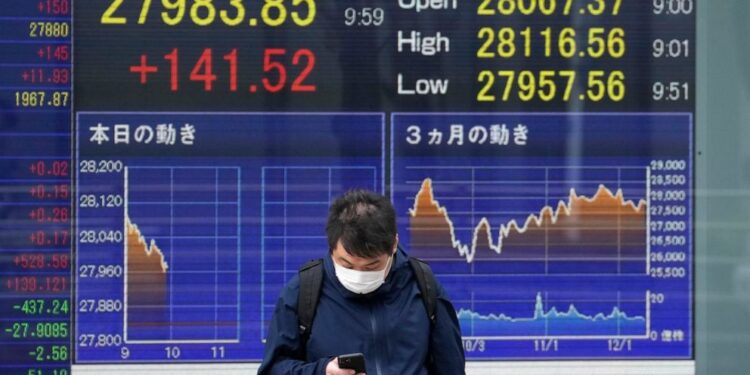Asian shares are mostly higher as the Federal Reserve and other central banks prepare for the year’s final barrage of interest rate hikes
Asian shares were mostly higher on Tuesday as the Federal Reserve and other central banks prepared for the year’s final barrage of interest rate hikes.
Tokyo’s Nikkei 225 rose 0.4% to 27,961.66 while the Hang Seng in Hong Kong gained 0.5% to 19,559.93. Australia’s S&P/ASX 200 picked up 0.3% to 7,203.30.
In Seoul, the Kospi shed 0.3% to 2,366.89. The Shanghai Composite index was flat at 3,179.71. Shares fell in India and Taiwan but rose in Singapore and Bangkok.
Markets have struggled this year thanks to high inflation and the interest rate hikes engineered to combat it. Higher rates slow business activity by design but also risk causing a recession if they go too high, all while dragging down the prices of investments.
On Wall Street on Monday, the S&P 500 rallied 1.4% to 3,990.56. The Dow Jones Industrial Average added 1.6% to 34,005.04. The Nasdaq climbed 1.3% to 11,143.74. The Russell 2000 gained 1.2% to 1,818.61.
The indexes were coming off their first weekly loss in three weeks.
Technology stocks accounted for a big share of the market’s gains. Microsoft rose 2.9% and was the biggest single force lifting the S&P 500. The London Stock Exchange Group agreed to a 10-year deal where it will move data to Microsoft’s cloud and spend at least $2.8 billion. Microsoft is also taking a 4% ownership stake in the company.
Horizon Therapeutics jumped 15.5% after Amgen announced it would acquire the biopharmaceutical company for about $26.4 billion.
The rally came ahead of a key inflation report on Tuesday and a meeting of policymakers at the Federal Reserve, after which investors expect the Fed to announce Wednesday its last rate hike of the year following a blitzkrieg that began in March.
The Fed has hinted it will dial down the size of its rate hikes, leading to expectations for a more modest increase of 0.50 percentage points Wednesday.
That would follow four straight mega-hikes of 0.75 percentage points. Each was triple the Fed’s usual move, and they lifted the central bank’s key overnight rate to a range of 3.75% to 4% after starting the year at virtually zero.
Other central banks around the world are also likely to raise their own rates by half a percentage point this week, including the European Central Bank.
Economists at Goldman Sachs expect Fed policymakers on Wednesday to signal their median expectation is for rates eventually to hit a range of 5% to 5.25%.
Even if inflation is waning, the global economy still faces threats from the rate increases already pushed through. The housing industry and other businesses that rely on low-interest rates have shown particular weakness, and worries are rising about the strength of corporate profits broadly.
The next big milestone for markets comes later Tuesday with the release of the latest update on inflation at the consumer level. Economists have forecast that inflation slowed to 7.3% last month from 7.7% in October.
Besides raising short-term rates, the Fed is also making other moves with its vast trove of bond investments that should effectively allow longer-term yields to rise.
The yield on the 10-year Treasury, which helps set rates for mortgages and other loans, rose to 3.61% from 3.59% late Friday. The two-year yield, which tends to more closely track expectations for the Fed, rose to 4.39% from 4.34%.
Energy producers rose Monday after the price of U.S. oil settled 3% higher. Exxon Mobil rose 2.5%.
U.S. benchmark crude added $1.04 to $74.21 per barrel in electronic trading on the New York Mercantile Exchange. Brent crude, the basis for pricing for international trading, picked up $1.15 to $79.14 per barrel.
Last week, crude prices scraped their lowest levels of the year on worries about a weakening global economy, which would mean less demand for energy.
In currency dealings, the dollar rose to 137.69 Japanese yen from 137.68 yen. The euro climbed to $1.0543 from $1.0534.
Source: abcNEWS



Recent Comments